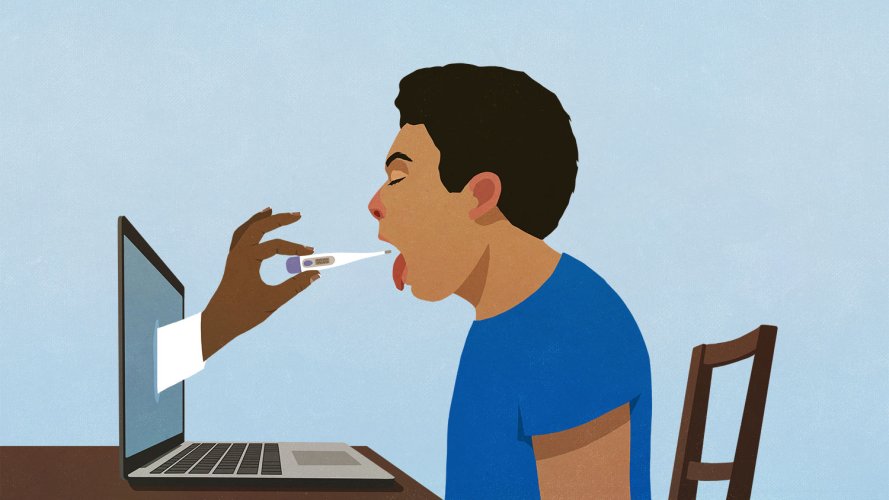Virtual Care Can Reach More Pediatric Patients and Drive Better Health Outcomes



See how a pediatric hospital is closing the access gap by delivering connected, comprehensive virtual care.
Virtual care has grown from an occasional phone call to a full-blown virtual operation. We now have the ability to deliver complex, trusted patient care from anywhere. Before the Covid-19 pandemic, virtual care adoption was slow going and represented less than 1% of overall health care volume. However, the past two years have proven that the need for healthcare beyond the doctor’s office is not only a “nice to have,” but a necessity.
Patients who never considered virtual care to be a reliable option now expect it. It’s more convenient and efficient. So much so that 60% of patients want to use technology more often when it comes to communicating, treating, and managing conditions. Virtual care is quickly becoming the next frontier with at least 25% of all outpatient, preventative, long-term care, and wellbeing services forecasted to move to digital delivery by 2040.
Powering the business of health
See how industry leaders are driving change across the globe.



Tackling complex issues with innovative care
I recently took a trip to Barcelona, Spain to take a deeper look at Hospital Sant Joan de Déu, a leading pediatric hospital in Europe established in 1867 and a pioneer in pediatric palliative care. Under the leadership of Dr. Sergi Navarno, president of the Spanish Society of Palliative Care (SECPAL), and Dr. Francesc Garcia Cuyàs, chief digital transformation officer, the hospital has set up, scaled, and executed comprehensive virtual care with great success. Their effective use of technology, dedicated specialists, robotics, and machinery has allowed them to work with a uniquely vulnerable pediatric population.
Closing the access gap
Hospital Sant Joan de Déu’s innovations prove the benefits of virtual care go far beyond the circumstances of the pandemic. Their scalable operation benefits countless children and families and supports the entire health and wellness journey including patient/family education, wellness checks, communications with care teams, and remote monitoring.
The facility now has the ability to reach beyond their immediate vicinity and work with kids who might not otherwise have access. As pediatric physician shortages grow, virtual care enables more children to benefit from the hospital’s treatment remotely, whether they’re at a rural clinic that doesn’t have pediatricians on staff or in the comfort of their home. It lifts the burden off patients and caregivers who would otherwise have to travel for appointments and allows doctors to see more patients. In short, Hospital Sant Joan de Déu’s ability to address complex conditions virtually through the combination of communication, technology, and devices on one platform has enabled their team to deliver better care no matter where their patients are.
How did they successfully innovate on virtual care?
Many of Hospital Sant Joan de Déu’s patients require a whole host of medical interventions. To deliver care virtually and successfully meet their patients’ specific needs, they had to develop an approach that would pair clinical and operational teams with tools and technology. All their data is centralized in a command center known as the Cortex project from which they can get a 360-degree view of the entire operation. The Cortex project lends oversight to everything from virtual care to ambulance dispatch, hospital maintenance, financial operations, logistics, and more. This approach makes it possible for the hospital to deliver more personalized, accurate, and accessible pediatric care from anywhere.
In addition to the Cortex project, the hospital partnered with technology companies to innovate care delivery. They use Teladoc Health to facilitate the hospital’s virtual care. Coupling care with connectivity, clinicians can speak with and monitor patients remotely. And with the help of robotics and intelligent machines, clinicians can even control and monitor devices like ventilators, EKG machines, and infusion pumps without having to be in the same room, streamlining the way complex care is delivered within the hospital, into other medical centers, or within a patient’s home.
Salesforce Health Cloud provides the patient data backbone. It serves as their single source of truth, assuring the right data is connected to the right patient. All clinical and non-clinical data is easily accessible in one central location, providing a comprehensive, easily digestible view of the patient. This not only increases efficiency and minimizes errors, but it allows hospital personnel to get to know the patients and their families more closely. The result is better, more informed, and timely care that builds trust and confidence.
What steps can providers take to mount similar virtual care operations?
Hospital Sant Joan de Déu has proven that combining communication, technology, and devices on one platform results in better, more accessible care. It allows clinicians to maximize resources and reach more people in less time. Digital health tools empower patients to take control of their health in the manner that best suits them, their lifestyles, and their personal preferences. What can providers who want to mount similar operations learn from this?
Hospital Sant Joan de Déu’s success relies both on strategic partnerships and a foundational data operation. Together, these enable them to:
- Connect disparate systems and centralize data in one accessible location
- Understand patient preferences and needs for care, communication, and treatment
- Provide complex specialty support remotely to local and international hospitals
Starting with this kind of foundation enables providers to answer critical questions and pinpoint areas ripe for innovation. As we move into the next era in healthcare, virtual care enables us to address new challenges, meet new expectations, and open up a new world of possibilities.
Deliver more accessible and trusted care from anywhere
Learn more about Hospital Sant Joan de Déu’s innovations in The Future of Virtual Care.




























